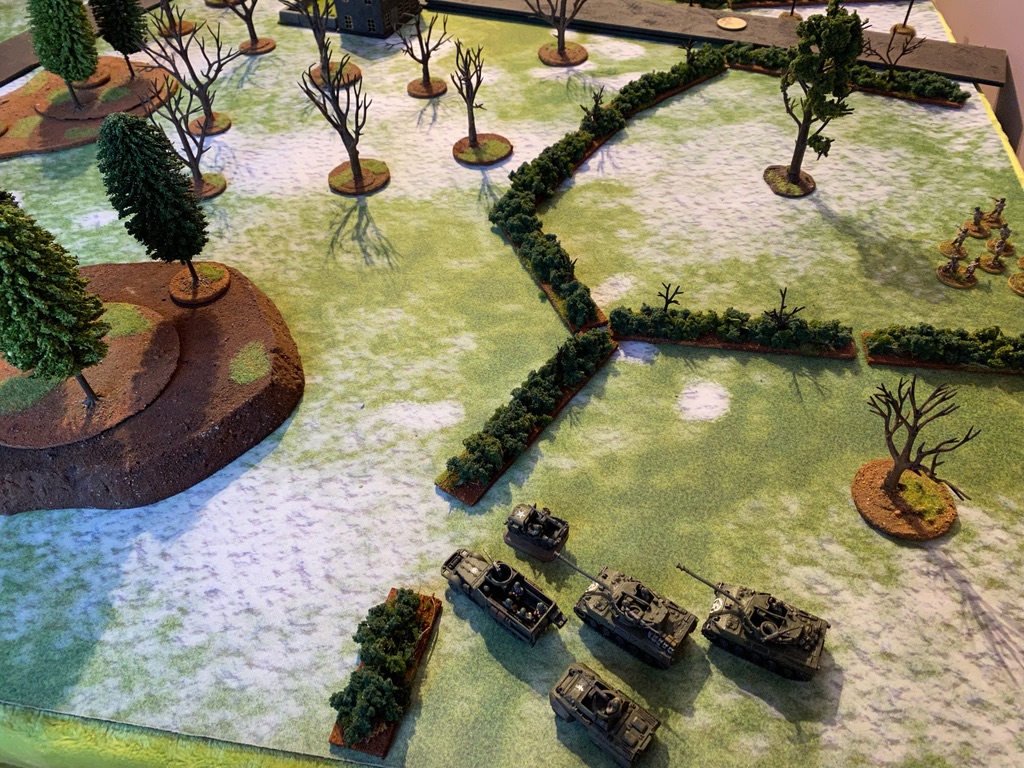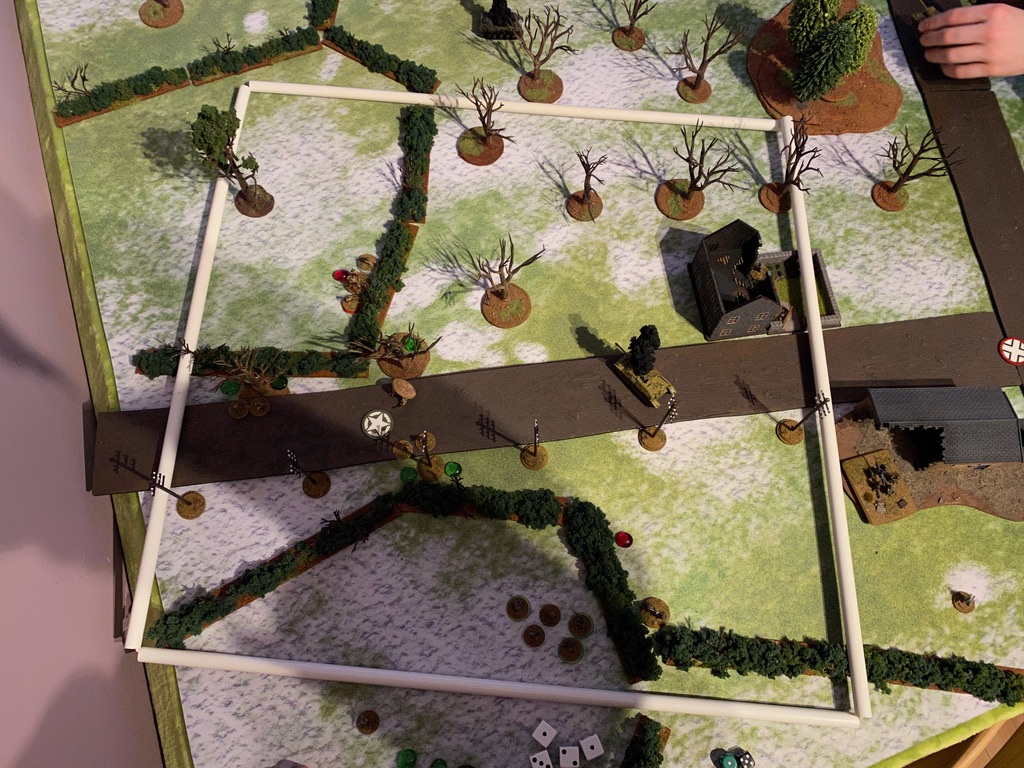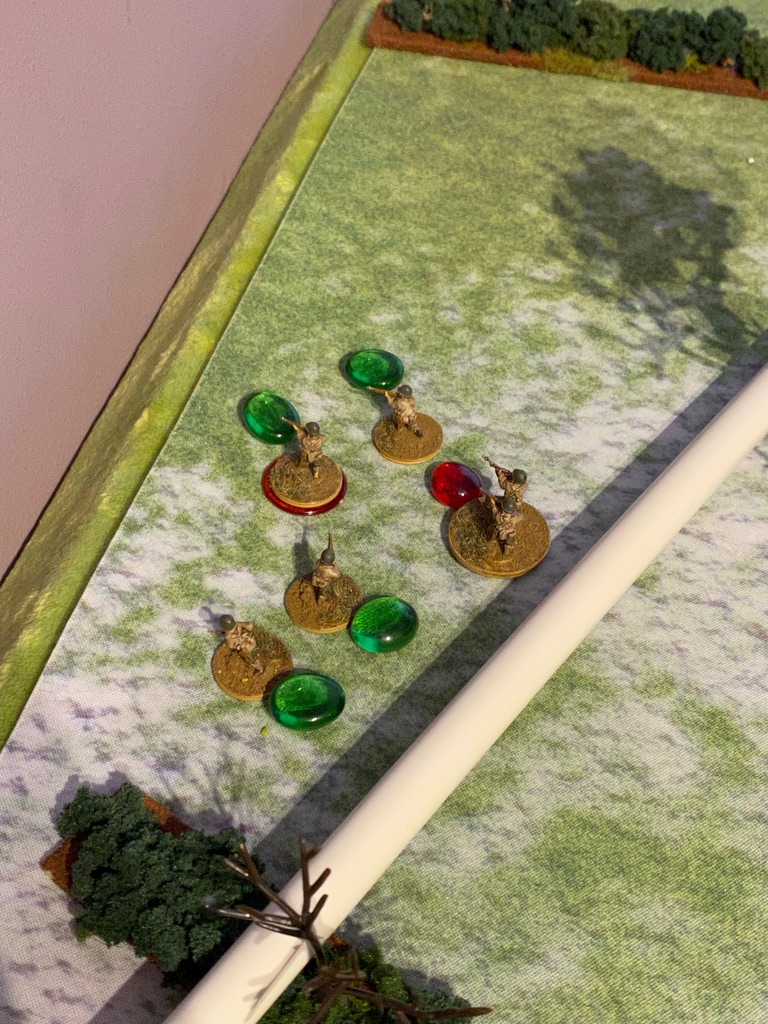During the Christmas break this year, I wanted to read up on the Ardennes Offensive. More than just read up on it, I wanted to play a few games inspired by it. I have the Battle of the Bulge supplements for both Nuts! and Battlegroup. Like all of the Battlegroup theatre books, the background is very well written and gives a real sense of the complex actions in a theatre. They offer a high level overview, but I wanted to delve a little deeper. Like any major military conflict, or even an individual battle, there’s probably a lifetime’s worth of material one could read. Herein lies the challenge – what could I read over two weeks to get a sense of this specific part of WWII.

I decided to give Anthony Beevor’s boom on the subject a go and it has proven to be a very well written and laid out piece, covering the build-up, day-by-day action and then the aftermath of Wacht am Rhein/Herbstnebel. With is as inspiration and having access to the wargames supplements, I decided to play through a few (solo) games. The first was based on an Intelligence and Recon squad from the 99th Division assessing the line late on the evening of the 16th December 1944.
Nuts! (Game 1)
Setup
The squad comprises 12 men and three jeeps as transport. Nuts! offers excellent solo play options. In this game, the squad is performing reconnaissance to the east of a small hamlet, just NE of Rocherath. They’re deployed on the closer edge, below, and three potential enemy forces are indicated by the Balkenkreuz markers.
Game















The reconnaissance initially went well, with a subset of the squad encountering a squad of Volksgrenadiers, but they saw them off and continued to probe towards the tree line. Gunfire erupted to their rear, as the .50 cal-armed jeep opened up on Germans that had outflanked their position. The two squads that had been on patrol remounted their jeeps (one squad had to wait for their jeep to fetch them) and then sped back to the hamlet. A fierce firefight broke out and casualties were heavy on both sides. The NCO and junior NCO were killed when their jeep was hit, causing it to crash into a wall and then they were caught by fire from a deadly accurate MG42. Three of the Americans were captured, particularly those injured in the crash or left stranded by it. The others managed to return to their lines to alert their CP of the approaching Germans, including what sounded like approaching armour.
Battlegroup (Game 2)
Forces and Setup
For the second game, I decided to shift the map/table westwards and to scale things up a bit using 300pt forces from Battlegroup. The Germans, from 277th VG, have control of the hamlet and are attacking westward. The Americans are seeking to establish roadblock, by blowing up trees and placing mines on the roads. The off road conditions are poor with wet ground, so they’re seeking to do anything they can to stall the German attack. I decided the Americans could complete additional objectives by performing engineering actions on the roads.
A hastily assembled Engineering force (254th Engr C Bn) supported by TDs (801st TD Bn), including the remnants of the I&R squad, is assembled to construct the roadblocks. German forces are drawn from 277th VG and 12th SS Panzer Division, with the infantry platoon having taken losses in the first game.
Here are the 300pt Battlegroup forces (both also happen to be 17 BR):
American Armoured Division (Overlord: Beyond the Beeches, P56)
- FHQ (in M20)
- 2x Jeep Recon Teams
- 2 x Self-Propelled TDs (M10)
- 2x Combat Eng Squad (in M3s)
- 4x 2nd Priority Artillery Support Requests
- Forward Observer Team
- Sniper
Volksgrenadier Division (Wacht am Rhein, P33)
- FHQ (Kübelwagen)
- Volksgrenadier Platoon
- HMG (MG42)
- AT Gun 2-i (Pak38 + Opel Maultier)
- Combat Medic
- 2x Jagdpanzer IV
Game
The mobility of the Americans made a difference in this game, with their ability to get onto objectives and to bring up vehicle-mounted MGs. The American’s also got quite lucky in the duelling with the Jagdpanzers, a bazooka from the Engineers taking out the second tank hunter (after both the American vehicles and one of the German ones had been disabled by AT fire). The Americans were victorious taking 12 BR to the Germans’ 20. They seized the objectives, but didn’t have time to complete the engineering works, so I decided that would make for an interesting game of Nuts! For that game, the starting situation would be exactly as the models had finished in the Battlegroup game.
Nuts! (Game 3)
Setup
I have a 2’x2′ square from playing Open Combat (which reminds me, I really should play that again soon!) and I placed it down over a portion of the Battlegroup game board, that covered a squad of engineers attempting to set a roadblock, while a (depleted) squad of Volksgrenadiers closed on them.
Game
This proved to be an excellent game. Nuts! again delivered a fun experience (as a side note – I think I’ve finally figured out how to play Nuts!). Everything went well for the engineers at the start, as then paired off and began setting satchel charges on roadside trees and telephone poles. Their BAR team provided covering fire, which initially kept the Germans at bay. The Germans had ducked back under fire, but recovered quickly, with the majority of their squad seeking to outflank the engineers, while their MG42 put fire into them. The MG team took a pair of engineers out of action just as they completed setting their charges. This led the another team to recover their comrades before the explosives blew. All the while the BAR tried to keep the MG’s attention away from those on the road. This worked, but at a cost. As the Americans got back into the cover of the hedge, their charges exploded, blocking the road. More accurate MG42 fire killed the BAR assistant and took two more engineers out of action. Carrying their wounded and killed squad mates, the Americans withdrew, hoping their work and sacrifice would be enough to stall the advancing German force.
These games proved an interesting way to explore a tiny bit of what fighting in the Ardennes in late 1944 might have been like. Reading the book gave a sense of how horrific warfare and specifically this battle was (is). The people caught up in it, and indeed all wars, were all scarred by it. If you’re (still) reading this, I hope you live in peaceful times. It’s easy to forget where the language of hate and intolerance can lead. The Battle of the Bulge was the last desperate attempt of a dying regime to change the course of a war they started. That regime gained power through the words of hatred. The language of everyday discourse is a battleground – calling out hatred and intolerance is the small thing we can do to try to ensure we live in a world where differences are not settled with lives.
Until next time,
Owen








































